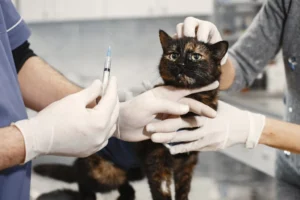Cats are known for their mysterious behavior, but when your feline friend starts crying when you touch her, it can be concerning. You may be wondering why this is happening and what you can do to help. In this blog post, we will explore the reasons behind why your cat may be crying when you touch her, as well as provide tips on how to address this issue.
Sensitivity to Touch
Does your furry friend seem to cry out when you touch her? It’s essential to consider that she might be sensitive to touch. Cats, like humans, have varying levels of sensitivity. Some cats enjoy hearty pats, while others prefer gentle strokes. Observe how your cat reacts to different touch pressures. If she cries when you touch her, try adjusting your touch to be more gentle and soothing. Pay attention to her body language – if she flinches or pulls away, she might be telling you that it’s too much for her. Remember, respecting your cat’s boundaries is crucial for building trust and a happy relationship.
Pain or Discomfort
It’s heartbreaking to see your beloved cat in pain or discomfort. If she cries when you touch her, it could be a sign that something is amiss. Look out for other signs of distress, such as limping, changes in appetite, or hiding. To rule out any underlying issues, a visit to the vet is always a good idea. Experts can conduct a thorough examination and provide the necessary treatment. Remember, cats are masters at hiding pain, so it’s essential to be vigilant in noticing subtle changes in behavior. By addressing any pain or discomfort promptly, you can ensure your cat’s well-being and happiness.
- Check for any lumps or bumps while petting your cat
- Take note of any unusual vocalizations or behaviors
- Consider her age and any previous injuries or health issues as potential causes for discomfort.
Remember, your cat’s well-being is a top priority, so always seek professional help if you have concerns about her health.
Behavioral Issues
When your cat cries when you touch her, it could be due to behavioral issues. Cats may cry if they are feeling stressed, anxious, or scared. They could also be seeking attention or expressing discomfort with certain interactions. To address these behaviors, try to provide a calm and stable environment for your cat. Create designated safe spaces for them to retreat to when they need a break. Additionally, engage in interactive play sessions to provide mental stimulation and build trust. If your cat’s crying persists, consider consulting with a professional animal behaviorist for further guidance.
Illness or Injury
If your cat is crying when you touch her, it could be a sign of illness or injury. Cats are masters at hiding pain, so vocalization during touch could indicate discomfort. Monitor your cat for any other signs of distress, such as changes in appetite, mobility, or litter box habits. It’s crucial to seek veterinary care if you suspect your cat is unwell. Remember, early detection and treatment can significantly improve your cat’s prognosis. Don’t hesitate to schedule a thorough examination with your veterinarian to rule out any underlying health concerns.
Additional Unique Insight: Did you know that excessive crying in cats could be a sign of a urinary tract infection? This condition can cause discomfort during urination and may lead to your cat crying when touched around her abdomen or hindquarters. If you notice your cat exhibiting this behavior, it’s essential to have her evaluated by a vet promptly to receive appropriate treatment.
Trust and Bonding
When your cat cries when you touch her, it could be a sign of a lack of trust or a weak bond between you two. Cats are sensitive creatures, and they need time to feel comfortable and secure around their humans. To help alleviate this behavior, focus on building trust and strengthening your bond with your feline friend.
One way to build trust with your cat is through positive reinforcement. Reward her with treats, gentle pets, and soothing words when she allows you to touch her without crying. This will help her associate touch with positive experiences and increase her trust in you over time.
Additionally, spend quality time engaging in activities that your cat enjoys, such as interactive play sessions or grooming. This will not only strengthen your bond but also help your cat feel more comfortable and secure in your presence.
Remember, trust and bonding take time and patience, so be consistent in your efforts and give your cat space when needed. By building a strong connection with your kitty, you can help reduce her crying during touch and create a more harmonious relationship.
Environmental Stressors
Is your cat crying when you touch her due to environmental stressors? Cats are highly sensitive to their surroundings, and certain factors in your home may be triggering this behavior. Creating a calming space for your feline companion can help alleviate her distress and reduce the crying during touch.
Ensure that your cat has a quiet and safe place to retreat to when she needs a break. This could be a cozy bed in a secluded area or a cat tree with a view of the outdoors. Providing hiding spots and vertical spaces can also help your cat feel more secure and less anxious.
Consider reducing environmental stressors such as loud noises, strong scents, or sudden movements that may be unsettling for your cat. Maintaining a consistent routine and providing enriching activities can also help reduce her overall stress levels.
By creating a peaceful and cat-friendly environment, you can help your feline friend feel more at ease and less likely to cry when you touch her. Remember, a stress-free environment is key to a happy and contented cat.
Additional Unique Insight: Comforting Scents
Introducing calming scents such as lavender or chamomile in your cat’s environment can help reduce anxiety and promote relaxation. Consider using a pet-safe diffuser or spray to create a soothing atmosphere for your furry friend. Just be sure to research and use essential oils that are safe for cats to avoid any potential harm.
Positive Reinforcement
When your cat cries during touch interactions, it may be a sign of discomfort or overstimulation. One way to address this is through positive reinforcement. By rewarding your cat with treats or praise when they remain calm and relaxed during touch, you can encourage desired behaviors. This can help your cat associate touch with positive experiences, reducing their tendency to cry or show signs of distress. Remember, patience is key when using positive reinforcement – consistency and reward will go a long way in changing your cat’s behavior.
Fun Fact
Did you know that cats use different vocalizations to communicate with humans and other animals? When your cat cries when you touch her, it could be a way of expressing discomfort or seeking attention. Understanding these vocal cues can deepen your understanding of your furry companion and help you respond appropriately to their needs. Keep in mind that each cat is unique, so take the time to learn your cat’s individual vocalizations and what they may signify. By paying attention to these cues, you can strengthen your bond with your feline friend and improve your communication with them.
Additional Unique Insight:
Cats may also cry when touched if they have sensitive areas on their body that they don’t like being petted. Pay attention to your cat’s body language and reactions to certain touch, as this can help you identify which areas may be causing discomfort or distress. By respecting your cat’s boundaries and preferences, you can create a more positive and enjoyable touch experience for both of you.
Alex, a passionate animal lover, has experience in training and understanding animal behavior. As a proud pet parent to two dogs and three cats, he founded AnimalReport.net to share insights from animal experts and expand his knowledge of the animal kingdom.









